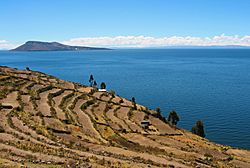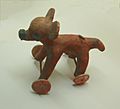Columbian Exchange facts for kids
The Columbian Exchange, sometimes called the Grand Exchange, was the exchange of goods and ideas from Europe, Africa, and Asia, and goods and ideas from the Americas. It also spread different diseases. It started in 1492 when Christopher Columbus arrived in the West Indies (North America).
The exchange of plants and animals changed many people's ways of life. Here are some examples:
- Before 1492, potatoes were only grown in South America. By the 1840s, Ireland depended on potatoes so much that a diseased crop led to the Irish Potato Famine. Many people were forced to move or starve.
- When the horse was imported from Europe, Native American tribes on the Great Plains were able to travel and hunt bison on horseback.
- Italy became famous for its Tomato sauce, made from American tomatoes.
- Coffee from Africa and sugarcane from Asia became the main crops of very large Latin American plantations.
- The chili and paprika from South America was introduced in India by the Portuguese. They have become an important part of Indian cuisine.
Before the Columbian Exchange, there were no oranges in Florida, no bananas in Ecuador, no paprika in Hungary, no zucchini in Italy, no pineapples in Hawaii, no rubber trees in Africa, no cattle in Texas, no chili peppers in Thailand and India, no cigarettes in France, and no chocolate in Switzerland. Even the dandelion was brought to America by Europeans for use as an herb.
Before there was regular communication between the two hemispheres, there were more domesticated animals and diseases in the Old World than in the New World. Smallpox, a disease from the Old World, killed many Native Americans.
There is very little of the earth that has remained the same since the Columbian Exchange.
Table of comparison
| Pre-Columbian Distribution of Organisms with Close Ties to Humans | ||
| Type of organism | Old World list (what they had) | New World list (what they had) |
| Domesticated animals | ||
| Domesticated plants |
|
|
| Infectious diseases |
|
|
Images for kids
-
Slaves working at a plantation in Virginia, depicted in 1670
-
A figurine featuring the New World's independently invented wheel. Among the places where wheeled toys were found, Mesoamerica is the only one where the wheel was never put to practical use before the 16th century.
-
Native Americans learned to use horses to chase bison, dramatically expanding their hunting range.
See also
 In Spanish: Intercambio colombino para niños
In Spanish: Intercambio colombino para niños








